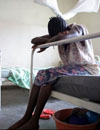
Rape as a weapon of war is not a new phenomenon, nor is it an exclusively African phenomenon. Ancient historian Homer documented instances of war rape in his writings. Tens of thousands were raped during the Second Sino-Japanese War in the Chinese city of Nanking. Serbian soldiers committed widespread rape against Bosnian-Muslims during the breakup of the former Yugoslavia. Rape was carried out as a tool of genocide during the slaughter of the Tutsi and moderate Hutu populations in Rwanda. A recent article in The Economist details this use of rape as a weapon of war that has left too many victims overlooked around the world.
Despite recent worldwide efforts to curtail this practice—the Geneva Conventions, a U.N. Security Council resolution acknowledging rape as a weapon of war, and the prosecution of rape as a tool of genocide by the Rwanda tribunal—rape continues to be used by armies and militias to prosecute their war aims. According to The Economist:
The anarchy and impunity of war goes some way to explaining the violence. The conditions of war are often conducive to rape…Many recent conflicts have involved not organized armies but scrappy militias fighting amid civilians. As wars have moved from battlefields to villages, women and girls have become more vulnerable…Every house in now on the front line.
In the course of such irregular war, rape has been used as a means of subduing foes and paralyzing civilians into non-resistance. This is particularly true of the rapes that continue to plague the population of eastern Congo. Most recently, at least 33 people were raped at the hands of the Congolese army. Last fall, when over 300 civilians were raped in Walikale, rape was a deliberate tactic of the militias.
The struggle over resources and rape is inextricably linked in Congo’s history, as it is today. In King Leopold’s era, the insatiable demand for rubber and ivory led the king’s soldiers and colonist-appointed leaders to raze villages, cut off people’s hands, and rape women as punishment for failing to meet the rubber or ivory quota and to generally subdue local communities. This legacy of sexual violence is apparent in Congo invasions to date. Rape has been used throughout the Kivus by Hutu combatants who fled over the border from Rwanda in the wake of the 1994 genocide, by Rwandan and Ugandan army units, ex-CNDP, and other local armed groups, often with the intent of grabbing hold of strategic mineral reserves.
Local organizations have recorded how even after an armed group has established control of a mine, rape is used to maintain control by intimidating the local population. Goma-based civil society organizations have documented cases of rape and gang rape in the large Bisie mine in Walikale, for instance.
Locally, the link between control of minerals and rape is well understood. For example, Enough Congo researcher Fidel Bafilemba recently pointed to a six-day battle instigated by Rwandan and Ugandan soldiers in the city of Kisanga in May 2000. The civil society there reported numerous cases of rapes of women and girls. It was clear what the soldiers were after: Kisanga’s minerals, mostly diamonds and gold.
In eastern Congo, rape is beyond being a by-product of war. In order to achieve real peace and security in the Congo for women and the population at-large, it is necessary to confront rape as a fundamental issue.
Creating a lasting peace in the Congo will require a multi-dimensional approach from numerous actors that addresses the various root causes of conflict. However, one of the main aspects to address is the ability of armed groups in the region to fund their atrocities through the illegal multi-million dollar trade of conflict minerals.
The establishment of a mineral certification scheme—created with the leadership of the U.S. and regional governments and the close involvement of the private sector and civil society—would lend credence to the transparency process and shift the incentive structure from one that elevates the trade of illegal minerals to one that increases the profitability of legal mining. A certification process would help to change the economic and political calculations of the armed groups in the region and pave the way for robust security sector reform in Congo.
As The Economist points out, the women of Congo have been overlooked throughout the crisis. The establishment of a mineral certification scheme to undermine the funding of armed militias and criminal elements of the Congolese army could be a critical first step towards creating a more peaceful future for Congo’s women.
Fidel Bafilemba contributed to this post from Goma.
Photo: Woman in a clinic in eastern Congo

